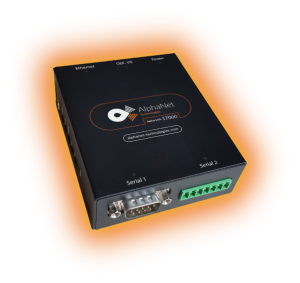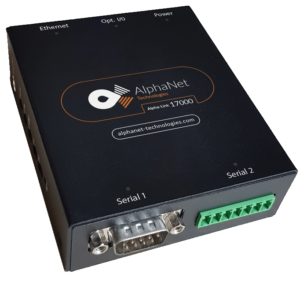In the fast-paced world of industrial automation, seamless and efficient communication is the key to optimizing operations, improving productivity, and staying competitive. The AlphaNet AT17000-MMt Gateway Converter Series emerges as a powerful solution, offering a bridge between different communication protocols within industrial networks. In this article, we’ll explore the significance of industrial network communication, the challenges it presents, and how the AT17000-MMt Gateway Converter Series revolutionizes the landscape.
The Importance of Industrial Network Communication
The Backbone of Industry 4.0
Industrial network communication serves as the backbone of Industry 4.0, the era of smart manufacturing and automation. Here’s why it’s crucial:
- Efficiency: Seamless communication ensures that data flows effortlessly between devices, reducing bottlenecks and delays in decision-making. It streamlines processes, leading to higher efficiency.
- Productivity: Effective communication enables devices and machinery to work in harmony, optimizing production processes, reducing downtime, and boosting overall productivity.
- Cost Savings: Reduced manual interventions, more efficient processes, and better resource allocation translate to cost savings, a vital factor in today’s competitive industrial landscape.
- Scalability: As industries grow and evolve, the ability to easily integrate new devices, technologies, and systems into the network is essential. Seamless communication allows for scalability without disruption.
The Challenges of Industrial Network Communication
Navigating the Complex Terrain
While the benefits of seamless communication are evident, achieving it within industrial networks can be challenging due to various complexities:
- Diverse Protocols: Industrial devices often use different communication protocols. The coexistence of various protocols necessitates protocol translation and compatibility.
- Legacy Systems: Many industries still rely on legacy systems that may use outdated communication methods. Integrating these systems with modern networks presents challenges.
- Real-Time Demands: Industries require real-time data for monitoring and control. This places a premium on networks that can deliver timely information without latency.
- Security Concerns: Ensuring data security is paramount. Industrial networks must protect sensitive information and systems from cyber threats.
Strategies for Achieving Seamless Communication
Overcoming the Challenges
Several strategies and technologies are employed to achieve seamless communication within industrial networks:
1. Protocol Translation Gateways
Protocol translation gateways, like the AlphaNet AT17000-MMt Gateway Converter Series, are instrumental in achieving seamless communication. These devices act as bridges, translating and facilitating communication between devices with different protocols. Whether it’s translating Modbus RTU to Modbus TCP or other protocol conversions, these gateways ensure compatibility and smooth data exchange.
2. Edge Computing
Edge computing brings data processing closer to the source, reducing latency and enabling real-time analysis and decision-making. Edge devices, equipped with computing power and communication capabilities, facilitate local data processing and can operate autonomously, even in the absence of a centralized network.
3. Industrial IoT (IIoT)
The Industrial Internet of Things (IIoT) connects industrial devices and systems to the internet, enabling remote monitoring, data analysis, and control. IIoT devices, sensors, and platforms collect and transmit data, providing valuable insights for optimizing industrial processes.
4. Secure Communication Protocols
Implementing secure communication protocols, such as VPNs (Virtual Private Networks) and encrypted connections, ensures the confidentiality and integrity of data transmitted over industrial networks. Robust security measures are crucial for protecting sensitive industrial data from cyber threats.
5. Redundancy and Reliability
Building redundancy into the network infrastructure enhances reliability and fault tolerance. Redundant communication paths and failover mechanisms ensure that communication remains uninterrupted, even in the event of network failures.
The Role of AlphaNet AT17000-MMt Gateway Converter Series
Bridging the Protocol Divide
The AlphaNet AT17000-MMt Gateway Converter Series takes center stage as a technology that empowers seamless communication within industrial networks. It serves as a bridge between Modbus RTU/ASCII devices and Modbus TCP networks, enabling devices with different protocols to communicate harmoniously. Here’s how the AT17000-MMt Gateway Converter Series achieves this:
1. Protocol Translation
The AT17000-MMt Gateway Converter Series excels in protocol translation. It translates Modbus RTU/ASCII commands and data into the Modbus TCP format and vice versa. This ensures that Modbus RTU/ASCII devices can communicate effectively with Modbus TCP devices on the same network.
2. Real-Time Data Exchange
Industrial processes demand real-time data exchange. The AT17000-MMt Gateway Converter Series ensures that data flows in real time, providing timely insights for decision-making and control. This real-time capability is crucial for maintaining the efficiency and responsiveness of industrial operations.
3. Device Integration
Whether you have legacy Modbus RTU/ASCII devices or modern Modbus TCP devices, the AT17000-MMt Gateway Converter Series seamlessly integrates them into your industrial network. This flexibility is invaluable for maintaining and upgrading your network infrastructure as needed.
4. Remote Monitoring and Control
The AT17000-MMt Gateway Converter Series empowers remote monitoring and control of Modbus RTU/ASCII devices. This capability allows operators to troubleshoot, adjust, and optimize processes without being physically present at the device location, reducing downtime and operational costs.
Conclusion: A New Era of Industrial Connectivity
H3: Enabling Efficiency and Competitiveness
Seamless communication within industrial networks is not just a goal; it’s a reality that propels industries into a new era of efficiency and competitiveness. By employing the right strategies and technologies, such as protocol translation gateways like the AlphaNet AT17000-MMt Gateway Converter Series, industrial networks can navigate the complexities, achieve real-time communication, and harness the power of the Industrial Internet of Things (IIoT) for data-driven decision-making.


